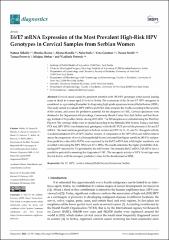E6/E7 mRNA Expression of the Most Prevalent High-Risk HPV Genotypes in Cervical Samples from Serbian Women

Date
2023Author
Nikolić, Nataša
Basica, Branka
Mandić, Aljoša
Surla, Nela
Gusman, Vera
Medić, Deana
Petrović, Tamaš
Štrbac, Mirjana
Petrović, Vladimir
Metadata
Show full item recordAbstract
Cervical cancer caused by persistent infection with HR HPV genotypes is the second leading
cause of death in women aged 15 to 44 in Serbia. The expression of the E6 and E7 HPV oncogenes is
considered as a promising biomarker in diagnosing high-grade squamous intraepithelial lesions (HSIL).
This study aimed to evaluate HPV mRNA and DNA tests, compare the results according to the severity
of the lesions, and assess the predictive potential for the diagnosis of HSIL. Cervical specimens were
obtained at the Department of Gynecology, Community Health Centre Novi Sad, Serbia, and the Oncology
Institute of Vojvodina, Serbia, during 2017–2021. The 365 samples were collected using the ThinPrep
Pap test. The cytology slides were evaluated according to the Bethesda 2014 System. Using a real-time
PCR test, HPV DNA was detected and genotyped, while the RT-PCR proved the presence of E6 and E7
mRNA. The most common genotypes in Serbian women are HPV 16, 31, 33, and 51. Oncogenic activity
was demonstrated in 67% of HPV-positive women. A comparison of the HPV DNA and mRNA tests to
assess the progression of cervical intraepithelial lesions indicated that higher specificity (89.1%) and positive
predictive value (69.8–78.7%) were expressed by the E6/E7 mRNA test, while higher sensitivity was
recorded when using the HPV DNA test (67.6–88%). The results determine the higher probability of detecting
HPV infection by 7% provided by the mRNA test. The detected E6/E7 mRNA HR HPVs have a
predictive potential in assessing the diagnosis of HSIL. The oncogenic activity of HPV 16 and age were
the risk factors with the strongest predictive values for the development of HSIL.
